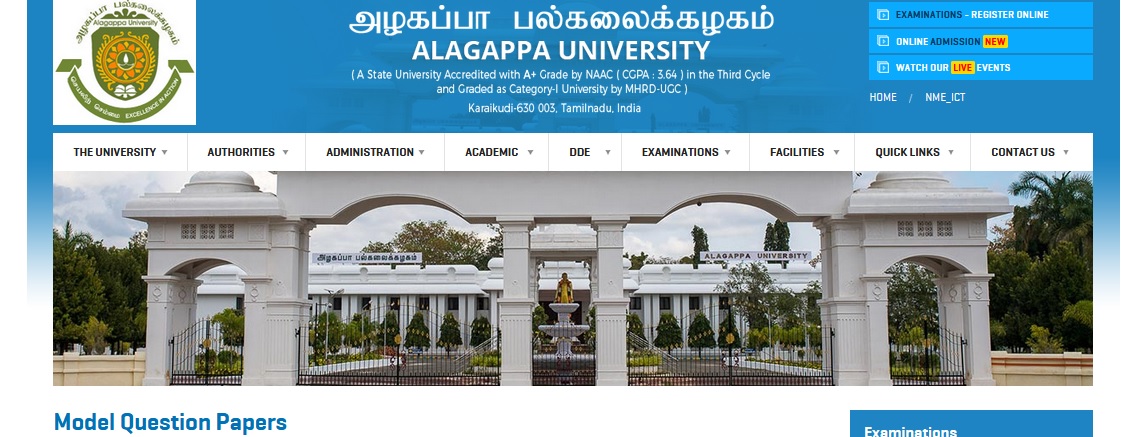Distributed Computing M.C.A Model Question Papers : alagappauniversity.ac.in
Name of the University : Alagappa University
Degree : M.C.A
Department : Computer Applications
Subject Code/Name : Distributed Computing
Document Type : Model Question Papers
Website : alagappauniversity.ac.in
Download Model/Sample Question Paper : Nov 2010 : https://www.pdfquestion.in/uploads/alagappauniversity.ac.in/4179.-MCA%20WEEK-END.pdf
Alagappa Distributed Computing Question Paper
M.C.A. (WEEK END) DEGREE EXAMINATION
DISTRIBUTED COMPUTING
Time : 3 Hours Maximum : 75 Marks
NOVEMBER 2011
Part – A :
Related : Alagappa University Digital Computer Organisation M.C.A Model Question Papers : www.pdfquestion.in/4275.html
1. What are the advantages of Distributed systems over Independent PCs –
2. What are the functions of Internet Protocol –
3. Define Protocol.
4. What do you mean by Skeleton –
5. What is the purpose of Process table –
6. What is meant by symmetric cryptosystem –
7. Define State and Method.
8. What is Logical Time –
9. What is the role of Locke in transaction –
10. What are the methods to avoid distributed deadlock –

11. (a) Explain the challenges of distributed systems.
(b) Discuss Network principles.
12. (a) Explain Group communications.
(b) Explain the basic RPC operations.
13. (a) Explain the Threads in distributed systems.
(b) Discuss Digital signatures.
14. (a) Explain Domain name system.
(b) Describe the distributed mutual exclusion.
15. (a) Explain nested transaction with an example.
(b) Discuss Transaction recovery.
16. Explain di fferent types of networks and its principles.
17. Describe the client-server communication methods.
18. Explain the Sun network file systems.
19. Explain the directory and discovery services.
20. Describe the distributed Multimedia systems.
NOVEMBER 2010
M.C.A. (WEEK END) DEGREE EXAMINATION
DIGITAL COMPUTER ORGANISATION
Time : 3 Hours Maximum : 70 Marks
Answer any five questions.
1. (a) Show decimal to binary, octal and hexadecimal number systems with examples.(6)
(b) Explain the significance of GRAY code and BCD code. How are errors detected in a digital system ?(8)
2. (a) State the prove De Morgan’s theorem for 3 variables with the help of a truth table. (6)
(b) What are universal gates ? Why are they called so ? Justify with illustrative logic diagrams.(8)
3. (a) For the Boolean function
F(xyz) = x’yz’+ x’yz + xyz’+xyz draw the truth table and a two-level implementation with minimum number of literals(6)
(b) Simply using Karnaugh map method, the function F = Sum(0, 6, 8, 13, 14) with d (A,B,C,D) = Sum(2, 4, 10) and draw a logic diagram using NAND gates only for the simplified function.(8)
4. (a) Explain Canonical form, Minterms and Maxterms.(6)
(b) Simplify using Tabulation method :
f = (w, x, y,z) = Sum Of (0,1, 2, 5, 7, 8, 9, 10, 13, 15) (8)
5. (a) Explain the working of a D flip flop and discuss any one application. (7)
(b) Discuss the different types of shift registers. (7)
6. (a) Draw the block diagram of a 16-bit binary ripple counter and explain its working. (7)
(b) Discuss the connection and working of an asynchronous decimal counter. (7)
7. (a) Explain half adders and full-adders. How are they used to construct a parallel binary adder ? (7)
(b) What are the different types of ROM ? Discuss the significance of each type of ROM. (7)
8. (a) Discuss the sequence of operation of control register.(7)
(b) Explain the DMA concept and I/O processors.
NOVEMBER 2006
Principles Of Information Technology (NCBCS—2006 onwards)
Time : 3 Hours Maximum : 70 Marks (5 × 14 = 70)
Answer five questions :
All questions carry equal marks.
1. (a) Describe the revolution of computers. (7)
(b) Write the impact of Information Technology on society. (7)
2. (a) Write the basic capabilities of Word Processor. (7)
(b) In what way the presentation software is useful ? Explain. (7)
3. (a) Describe the factors that affect the data transmission.(7)
(b) Write the merits and demerits of Video/Voice Communication.(7)
4. (a) Describe the criteria for rating secondary storage devices.(7)
(b) Explain the basic concepts of file management system. (7)
5. (a) What is programming ? Explain the process of programming development.(7)
(b) Write the security issues. (7)
6. (a) What do you mean by Internet ? Describe the activities that you can do on the Internet.(7)
(b) Describe the media that are used for communication system. (7)
7. (a) Describe the di fferent types of database organisation.(7)
(b) What is HTML ? What is its importance ? (7)
8. (a) What is an electronic spreadsheet ? What are the advantages of using a spreadsheet ? (7)
(Or)
(b) Discuss about cyberethics. (7)